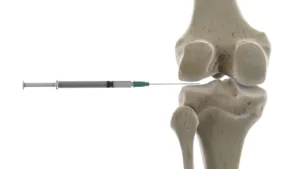When persistent shoulder pain severely limits your life, two significant orthopaedic solutions often come into discussion: rotator cuff repair and shoulder replacement. While both aim to alleviate pain and restore function, they address different underlying problems and have distinct considerations. Dr Bradley Richmond is dedicated to providing you with clear information and a patient-centred approach to help you understand which path is right for your unique situation.
Understanding rotator cuff repair
Rotator cuff repair is typically performed to fix one or more torn rotator cuff tendons – tendons that help lift and rotate your arm.
- Primary Indication: This surgery is for patients with a significant acute traumatic or sub-acute rotator cuff tear that causes pain, weakness, or limits the ability to lift the arm. Unless traumatic and complete, non-operative treatments (like physiotherapy, steroid injection) are often trialed prior to proceeding to surgery.
- The Procedure: During the surgery, the torn tendon is reattached to the bone, most commonly performed using minimally invasive (arthroscopic) techniques through small incisions. The goal is to restore the integrity of the tendon, allowing it to heal back to the bone.
- Expected Outcome: Successful rotator cuff repair aims to reduce pain, restore significant strength, and improve the range of motion in the shoulder, enabling a return to daily activities and often sports.
- Rehabilitation Focus: Post-operative rehabilitation is crucial and typically involves six weeks in a sling to protect the healing repair, followed by a structured physiotherapy program to regain strength and mobility over several months.
Understanding shoulder replacement
Shoulder replacement surgery, including options like the Zimmer Comprehensive Shoulder Replacement, is a more extensive open procedure.
- Primary Indication: Shoulder replacement is indicated for moderate to severe shoulder Osteoarthritis, chronic rotator cuff tears not amenable to repair which have caused “Rotator Cuff Arthropathy” or to treat certain Complex Fractures where the joint surfaces are significantly damaged. It replaces damaged bone and cartilage with artificial (metal and plastic) components.
- Types: (i) Anatomic total shoulder replacement (replacing both the ball and socket) or (ii) Reverse total shoulder replacement (where the ball and socket components are reversed) – often used when the rotator cuff is severely damaged and irreparable.
- Expected Outcome: Shoulder replacement offers profound pain relief and significant improvements in range of motion, allowing patients to perform activities like dressing, reaching, and sleeping more comfortably.
- Rehabilitation Focus: Rehabilitation is also essential, beginning with protected motion in a sling, gradually progressing to exercises guided by a physiotherapist over several months.
Key considerations for choosing the right path
The choice between rotator cuff repair and shoulder replacement hinges on a careful assessment of your specific diagnosis, the extent of the damage, and your personal goals.
- Underlying Condition: Is the primary issue an acute traumatic or subacute rotator cuff tear OR irreversible joint surface destruction (due to Osteoarthritis, Rotator Cuff Arthropathy, or Fracture)?
- Joint Integrity: Can the natural joint be preserved and function restored by fixing the soft tissues, or is the joint itself too damaged to function effectively? Imaging (like X-ray, MRI, and CT) will be used to assess the integrity of the cartilage and bone.
- Patient Goals and Expectations: What are your main priorities? Is it pain relief, restoring specific movements, or returning to certain activities? Dr Richmond will discuss what each procedure can realistically achieve for your circumstances.
Surgeon’s Expertise: Both procedures require significant skill. Dr Richmond will guide you based on his extensive experience with both rotator cuff repair and shoulder replacement surgery.
If you’re experiencing chronic shoulder pain and exploring your options, Request a Consultation with Dr Richmond for a comprehensive assessment.




